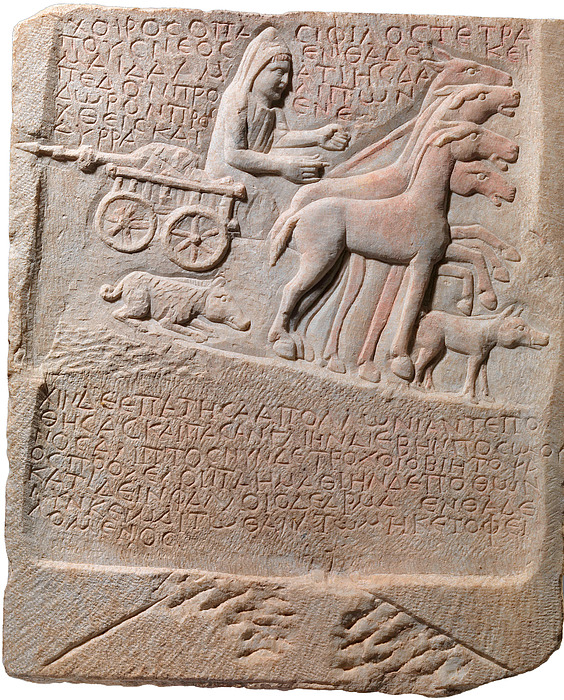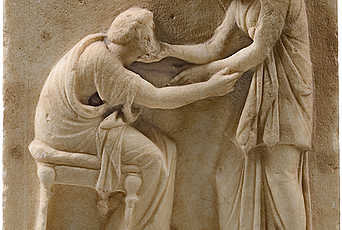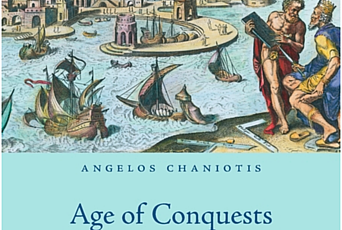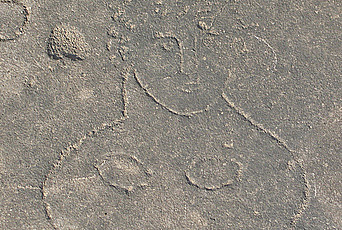A Brave New World: Hellenism from Alexander to Hadrian

In 327–326 B.C.E., Alexander the Great, after having defeated the Persian King and conquered the Persian Empire, crossed eastern Iran, Afghanistan, and Bactria, testing the limits of his abilities. He attacked the fortress of Aornos, on Mount Pir-Sar in Pakistan, which was regarded as unconquerable. Even his ancestor Heracles had failed to conquer it, so the myth went. At about the same time that Alexander attempted to surpass Heracles, where the hero had failed in his easternmost adventure, another Greek undertook a daring enterprise at the place marking Heracles’s westernmost deed: the Pillars of Hercules, or modern Gibraltar. Around 325 B.C.E., the geographer and mariner Pytheas of Massalia embarked on an expedition to explore the western ocean. After breaking the Carthaginian blockade of the Straits of Gibraltar, he sailed along the coast of Portugal in an attempt to circumnavigate Europe. In the course of his journey, he discovered the British Isles, possibly reached Norway or Iceland—depending on where one locates the place the ancients called Thule—and sailed deep into the Baltic Sea. Although it is unlikely that Alexander ever learned of Pytheas’s enterprise, it is not by chance that these adventures were more or less contemporary. Both Pytheas and Alexander were motivated by the same inquisitive spirit and fascination with the unknown. Around this time, in the more comfortable venue of the Athenian Lyceum’s shady gardens, Aristotle and his pupils were pursuing a plan to map, analyze, and classify the entirety of the visible world and all aspects of human behavior. Pytheas in the West, Alexander in the East, and Aristotle in Greece’s intellectual center are parallel culminations of decades of Greek scientific exploration, which in the late fourth century B.C.E. was breaking new paths.
After Alexander had opened up new horizons in the East, others followed, guided by plans or fortune. The universal scholar Poseidonios, while visiting Gades (modern Cadiz in Spain) and studying the tides on the Atlantic coast in the early first century B.C.E., heard about the adventures of a certain Eudoxos of Kyzikos a few years earlier. His work On the Ocean is lost, but an account of Eudoxos’s expeditions is preserved in the Geography of Strabo. Eudoxos came to Egypt as an envoy. He joined up with the king in his voyages up the Nile. During one of these journeys, an Indian was brought to the king by the garrison of the Red Sea, who reported that they had found him shipwrecked. The Indian was handed over to people to teach him Greek. Once he had learned it, his story was that he was sailing from India when he happened to lose his way and ended up safely after his fellow sailors had died of starvation. He was taken at his word and promised to act as guide for the route to India to a crew selected by the king. Eudoxos was one of them. So, he sailed off with presents and returned with a cargo of perfumes and precious stones. He was soon deceived in his hopes as the king appropriated the whole cargo.
What Eudoxos learned from the Indian sailor was the use of the monsoon winds that permitted a direct journey from Ethiopia to India through the Indian Ocean, avoiding the long, expensive, and dangerous journey along the southern coast of Arabia and through the Gulf of Oman. In 116 B.C.E., the king died and Eudoxos was sent on a new expedition, which again filled his ship with luxuries—probably spices, perfumes, and precious stones. The return journey was adventurous; the ship was stranded somewhere between Cape Guardafui in Somalia and Zanzibar. Eudoxos managed to return to Alexandria, only to see his cargo confiscated, again, by the new king. Then Eudoxos tried his luck in the West. He went to Gades in Spain, with the plan to circumnavigate Africa and reach India through an alternative route. He failed, and the king of Mauritania delivered him to the Roman general Sulla. He attempted a fourth journey, from which he never returned. The way this story is narrated by Poseidonios corresponds to Hellenistic taste: fortune stages an encounter between a shipwrecked Indian, a curious Greek, and an avaricious king. And as in many Hellenistic stories, there are unexpected twists of fate and thwarted expectations. The adventures of Eudoxos exemplify, to an extreme level, the new possibilities that the Hellenistic world created for trade in exotic products and the dissemination of information. This was in part endorsed by royal patronage, unknown before Alexander.
A travel handbook known as the Circumnavigation of the Erythraean Sea (Periplous Maris Erythraei), probably composed in the mid-first century C.E., provides detailed information about the harbors, trading posts, and products to be found along the coasts of the Red Sea, the Persian Gulf, and the Indian Ocean. For instance, merchants interested in importing frankincense from the Arabian Peninsula learned that
after Arabia Felix there is a continuous length of coast, and a bay extending two thousand stadia or more, along which there are Nomads and Fish-Eaters living in villages. Just beyond the cape projecting from this bay there is another market-town by the shore, Kana, of the Kingdom of Eleazos, the Frankincense Country; and facing it there are two desert islands, one called Island of Birds, the other Dome Island, one hundred and twenty stadia from Kana. Inland from this place lies the metropolis Sabbatha, in which the King lives. All the frankincense produced in the country is brought by camels to that place to be stored, and to Kana on rafts held up by inflated skins after the manner of the country, and in boats.
This text shows in the most impressive way how far knowledge of these regions had advanced since the time of Nearchos, the admiral of Alexander who traveled from India to the Persian Gulf in 327 B.C.E. Under Nero, when the Roman emperor enjoyed diplomatic relations with rulers in Arabia, his subjects risked trading journeys along the coast of the Arabian Peninsula and as far east as India and Sri Lanka. Trading activity with these regions was quite diverse. For instance, the important harbor of Barygaza in northwest India was a place where Roman and Greek traders could profitably sell wine, textiles, and silver vessels, as well as singing boys and beautiful girls for the king’s harem, receiving in exchange semi-precious stones, herbs, spices, and exotic animals.
A certain Sophytos, a man who died in Alexandria Arachosia (today’s Kandahar) in the late first century B.C.E., may be one of the traders who visited Barygaza. In the elaborate grave epigram that he composed for himself, he gives an account of his achievements. His ancestral fortune having been lost, Sophytos sought ways to raise the ancestral home high again. He took a loan and left his city, determined to return only as a rich man. His maritime enterprises must have been in the Indian Ocean. From Kandahar he could have easily reached the harbor of Barygaza, and from there his trips may have brought him as far as Egypt. He returned a wealthy man, rebuilt the ancestral house, erected a new grave for his ancestors and himself, and composed a poem in Greek for the Greek population that must have still been living in Alexandria Arachosia. The archaeological exploration of harbor sites in southern India and the discovery of Roman coins and wine jars there corroborate the advancement of Greek trade with these areas in the early imperial period.
The impetus for such connections came from Alexander. His campaign was the “big bang” of Hellenistic “globalization,” as it were.
“Six degrees of separation”: an ancient “globalization”
The film Babel, released in 2006, shows how the fate of a handful of people in Morocco, Japan, Mexico, and the United States—people who are strangers to one another—is connected because of certain circumstances. This drama, directed by Alejandro González Iñárritu and written by Guillermo Arriaga, is one of many films, plays, and television series that are based on the theory that everyone is six or fewer steps away, by way of relationships or acquaintances, from any other person in the world. This concept was first formulated by the Hungarian author Frigyes Karinthy in his 1939 short story “Láncszemek” (“Chains”). It became known through the work of the social psychologist Stanley Milgram, author of “The Small-World Problem,” published in Psychology Today in 1967. In the words of a character in the 1990 play Six Degrees of Separation by John Guare: “Six degrees of separation between us and everyone else on this planet. The President of the United States, a gondolier in Venice, just fill in the names.” In the age of the internet, Facebook, and Twitter, this concept seems archaic.
It cannot be seriously claimed that when Alexander the Great ascended the throne of Macedonia in 336 B.C.E. there were six degrees of separation between him and any individual living in the areas that would, ten years later, comprise his empire. By contrast, it is not unreasonable to assume that when Hadrian ascended the throne of Rome 453 years later there were six, or fewer, degrees of separation between the emperor and any individual in his empire and in the adjacent states. Even a simple fellah in south Egypt knew a village secretary, who communicated with the village chief, who had a contact with the governor of the district, who knew the governor of Egypt, who had been appointed by the emperor. The developments that Alexander’s campaigns set in motion ultimately led to the creation of a complex network of political, administrative, economic, and cultural connections that came close to the modern phenomenon of globalization. Of course, this network did not extend over the entire globe, but it did cover the region that contemporaries knew as the oecumene, “the inhabited earth.” One might more appropriately speak of “ecumenization.”
The conquests of Alexander destroyed the Persian Empire but did not create a lasting empire to replace it. Nonetheless, they did engender a huge political network of kingdoms, semi-independent dynasts, and poleis extending from the Adriatic Sea to Afghanistan and from the north shore of the Black Sea to Ethiopia. These states also had relations with Italy, the Greek poleis of Magna Graecia and Rome, the Greek colonies in the south of France, Carthage in North Africa, and the Mauryan Empire in India. Thus, the world of Alexander’s successors constituted a network that comprised the entire known world, with the exception of East Asia. But if we also consider various population movements—for instance, the migration of the Gauls into Greece and Asia Minor in the early third century B.C.E., the invasion of the Yuezhi and other nomadic tribes into Bactria in the second century B.C.E., and the repeated raids of Scythians and other tribes into the territories of the Greek cities—the world of Alexander’s successors was also connected with central Europe, central Asia, and the western borders of China. The Roman expansion from the late third century B.C.E. onwards gradually enlarged the borders of this network of interconnected regions to include the Iberian Peninsula, central and western Europe, Britain, and north Africa. By the time of Hadrian’s death, a large part of the oecumene was within the borders of one single empire.
People (and animals) on the move
The development of a network of interconnected regions was accompanied by an unprecedented movement of populations. This ranged from the voluntary movements of mercenaries, artists, merchants, entertainers, itinerant orators and educators, students of oratory and philosophy, pilgrims journeying to sacred places, and athletes to the forced migration of exiles after civil wars, captives, slaves, and diaspora Jews. Some movements were periodical, as in the trips of the “sacred envoys,” who announced festivals, the visits of audiences to the great athletic contests in Olympia and Delphi, and the maritime journeys through the Indian Ocean that were determined by the monsoon winds. More often, they were determined by ad hoc needs, such as the trips undertaken by ambassadors to cities, kings, Roman authorities, and emperors. Movements could be massive, as with the settlement of Hellenistic new city foundations or Roman colonies, the Gallic invasions of Greece and then of Asia Minor, or the resettlement of Jews after their revolts. The movement of large groups was usually permanent, resulting in dramatic changes in the ethnic composition of the population and contributing to cultural diversity.
At the same time, the individual and temporary movements of people, especially of traders and scholars, had a significant impact on culture. Orators, philosophers, and historians traveled around the world, giving lectures in major cities and sanctuaries. Akroasis (public lecture) is the word that designates their main activity: visiting a city, a sanctuary, or a court, staying there for a few days or months, and giving lectures in gymnasia, theatres, town halls, and palaces. They read excerpts from historiographical works, presented philosophical and delivered encomia of cities and emperors, and offered advice on social and political issues. From the second century B.C.E. on, intellectuals came to Rome as ambassadors of their cities, others as friends of Roman statesmen, and yet others tried their fortune in the new metropolis of the world. A turning point in this respect was the “embassy of the philosophers” from Athens to Rome in 155 B.C.E., which was sent to appeal against the decision of the senate to impose a fine on the city. The lectures of Karneades, one day focusing on the defense of justice and the next against it, became famous; although Cato the Elder, a conservative Roman senator, made sure that the philosophers left the city immediately, their influence remained, and in the following decades the number of Greek intellectuals visiting Rome multiplied. The activities of itinerant historians, orators, grammarians, and philosophers—scholars who combined expertise in these fields were known as “sophists”—continued into the Imperial period, culminating in a time known as the “Second Sophistic,” lasting roughly from the reign of Nero to the early third century C.E.
“Go east” was the advice for most of the Greeks under those who succeeded Alexander, and it remained so for centuries. As Rome consolidated its position at the center of the oecumene and the pax Romana made journeys relatively safe, individuals and groups from Greece and the Hellenized provinces found their way to Rome, Italy, and the western provinces. Men of letters, actors, and athletes were a minority of such people, over-represented in our sources; most were slaves, traders, artists, and skilled workers. Occasionally, grave inscriptions tell these people’s stories, such as the sad case of Hyle from Thessalonike, who died alone in Bonn around 200 C.E.: “Thessalonike was my fatherland and Hyle was my name. Aisos, the son of Batallos, conquered me with love potions, although he was a eunuch. And so my wedding bed was ineffectual. And now I lie here, so far away from my fatherland.” In the small world of the Roman Empire, a woman from Thessalonike who followed her husband to Germany could still think of her fatherland with nostalgia.
Movement in this period involved not only the movement of people, but also the movement of objects. Looted works of Greek art decorated Roman houses and villas, and Roman clay lamps lit the houses of Asia Minor. Isolated objects of Greek and Roman manufacture even reached China, Thailand, and Korea, suggesting contacts, if not regular trade. And there was the movement of animals: horses and dogs from areas renowned for their special breeds, but also exotic creatures displayed in processions and triumphs or killed in the arena. The grave epigram of a traveling pig gives us an unusual insight into the mobility of this era. Probably trained to perform acrobatic tricks or to compete in races in festivals, the pig came all the way from Dyrrhachion on the Adriatic Sea to Edessa in Macedonia. On its way to a festival of Dionysus it was run over by a wagon (see above image):
Here lies “the Pig,” beloved by all, a young quadruped, having left the land of Dalmatia, brought as a present. I reached Dyrrhachion and wishing to see Apollonia I crossed every land with my own feet, alone, undefeated. But now I have left the light because of the violence of the wheels. I wished to see Emathie and the wagon of the phallus, but now here I rest, although I was too young to pay my tribute to death.
It is not possible to think of an earlier period in recorded human history in which movement was so intense, massive, and wide-ranging. However, the gradual political and cultural convergence of the oecumene that started with Alexander and continued advancing under the Roman emperors never uprooted local identities and allegiances.


